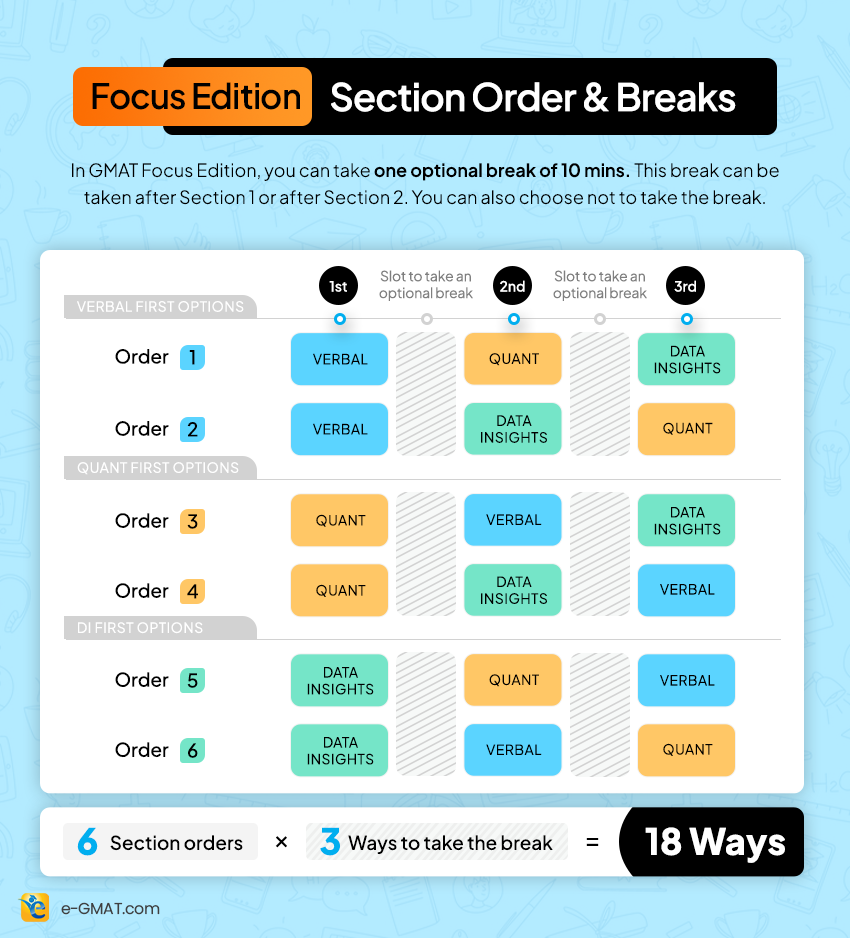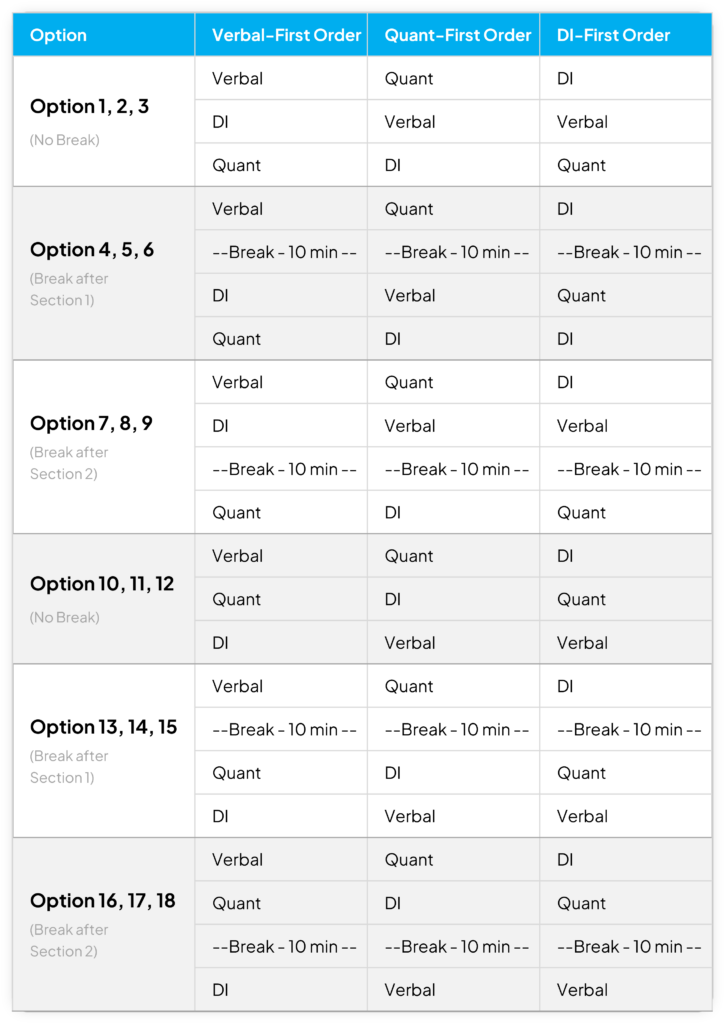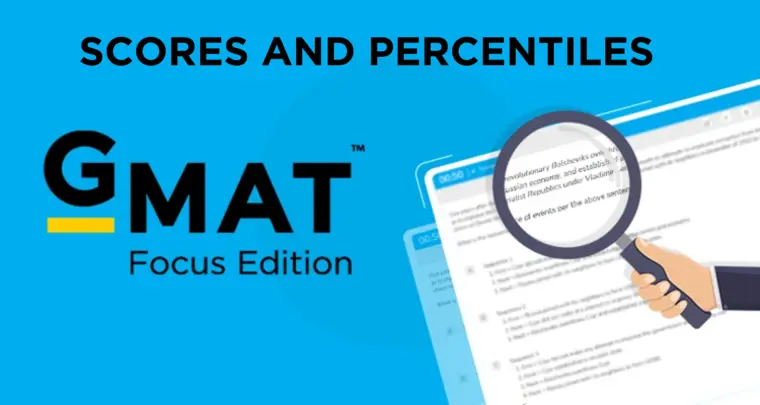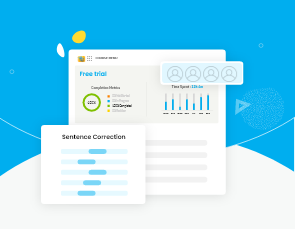This article answers all your questions about the GMAT Focus Edition Exam Format and Timing, GMAT Exam Structure, GMAT Sections, and GMAT Question Types.
The updated GMAT is a 2-hour and 15-minute exam, featuring an optional 10-minute break between any two sections. The exam is scored on a scale ranging from 205 to 805 and consists of three sections: Verbal Reasoning, Quantitative Reasoning, and the new Data Insights section.

The best way to understand the GMAT exam format is by trying the test out for yourself.
According to the Graduate Management Admission Council (GMAC) which owns the GMAT test, GMAT is a trusted and preferred part of the admissions process of more than 7,700 programs across 2,400 business schools worldwide.
This article covers the following sections:
GMAT Exam Format and pattern 2024 – Section-wise Distribution

What are the GMAT Sections?
- Data Insights
- Quantitative
- Verbal
Here’s a brief overview of each of these sections of GMAT:
1) Data Insights – According to GMAC – “The Data Insights section measures candidates’ ability to analyze and interpret data and apply it to real-world business scenarios. With the GMAT™ Focus Edition’s updated test design, Data Insights leverages Integrated Reasoning and Data Sufficiency question types to measure a newly calibrated digital and data literacy dimension—one of the most relevant and in-demand skills in business today.”
- Duration: 45 minutes
- 20 Questions of the following question types:
2) Quant – According to the GMAC “This section measures your algebraic and arithmetic foundational knowledge and how you apply this knowledge to solve problems. These types of questions require some knowledge of arithmetic and elementary algebra. Answering these questions correctly relies on logic and analytical skills, not the underlying math skills.”
- Duration: 45 minutes
- 21 Questions all of Problem-Solving type
3) Verbal – According to GMAC – “ This section measures your ability to read and comprehend written material and to reason and evaluate arguments.”
- Duration: 45 minutes
- 23 Questions from the following topics:
- Reading Comprehension (RC)
- Critical Reasoning (CR)
Read this article for a detailed, section-by-section breakdown of the GMAT syllabus and sample questions!
GMAT Format/ GMAT Exam Pattern
| GMAT Focus Edition Sections | No of Questions | Question types | Section duration |
| Verbal Reasoning | 23 | Reading Comprehension, Critical Reasoning | 45 minutes |
| Quantitative Reasoning | 21 | Problem Solving, (Algebra and Arithmetic) | 45 minutes |
| Data Insights | 20 | Data Sufficiency; Multi-source Reasoning; Table Analysis; Graphics Interpretation; Two-Part Analysis | 45 minutes |
If you are wondering how to understand GMAT Scores & Percentiles, here is what you should read!
If you are planning to take the GMAT, we can help you with a personalized study plan and give you access to quality online content to prepare. Write to us at acethegmat@e-gmat.com. We are the most reviewed GMAT prep company on gmatclub with more than 2700+ reviews. Why don’t you take a free trial and judge for yourself?
Overview | GMAT-Computer Adaptive Test
GMAT is a Computer Adaptive Test (CAT). This means that the testing software adapts to your performance as you progress through the test. Therefore, your performance on each question will determine the difficulty level of the next few questions in the exam. Consequently, the GMAT score is calculated on your ability level i.e. on the basis of the difficulty level of questions that you solve correctly and not just the number of questions that you get right.
Note All three sections – Verbal, Quant, and DI are computer adaptative. Read our deep-dive on how the Computer Adaptive GMAT Works. Understanding the test is the first step towards acing it.
In a computer adaptive test, based on your response, you will then receive an easier or more difficult question. Your score is a composite result that considers the difficulty of each question you got right and wrong. Because each question you answer directly affects the next question you get, the CAT does not allow you to go back to questions you’ve already answered during the test. But in the Focus edition, you will get a chance to bookmark a question and at the end of the section, time permitting, you are allowed to change the answers of up to 3 questions.
Are you aiming for a top score on the GMAT? Look no further! Discover the revolutionary Last Mile Push (LMP) program by e-GMAT, designed to provide personalized guidance and hyper-specific improvement plans.
Read this Article to know more – e-GMAT’s Last Mile Push Program: Personalized Preparation for Top GMAT Scores
GMAT exam – Section Order Selection | GMAT Structure
Prior to July 11, 2017, all test-takers had to take the test in that exact order as defined by GMAC. However, this is no longer the case. We’ll now discuss the order in which you can take the GMAT sections.

You can take the exam in any order with only one optional 10-minute gap between any of the two sections, so you have 18 options in total.
Begin your GMAT preparation with the only prep company that has delivered more 700+ scores (645+ scores) than any other GMAT club partner. Achieve GMAT 685+ with our AI driven tools that you personalized feedback at every step of your GMAT journey. Take our free trial today!
This is GMAC’s attempt to help you build comfort and confidence on exam day. You can choose the order in which you want to take the GMAT sections, just before your exam begins.
As per GMAC, “There is no “correct” or “recommended” GMAT section order to select. This choice gives you more control and flexibility.” For more details, please refer to this article on GMAT Exam Format – Select Section Order.

If you’re looking for the right strategy to ace the GMAT, attend our GMAT Strategy webinar, where we help you create a plan to achieve your target GMAT score.
GMAT Exam Format or Pattern – Update & Impact
The previous edition of GMAT is not available from 1st of February 2024 and the students can only opt for GMAT Focus edition.
We invite you to read our GMAT Focus Edition Series Articles, an invaluable resource to keep you at the forefront of your GMAT preparation journey.
You can also read the following articles on:
- Section-Wise Details and Question Types
- GMAT Eligibility Criteria
- GMAT Cost and Fees
- GMAT Score & Statistics
- GMAT Score Reports
- GMAT Books and Resources
- GMAT Test Centers
- GMAT Exam Day Tips
If you have any doubts regarding the format of GMAT EXAM, GMAT Exam Structure or need help with planning your GMAT Prep, feel free to write to us at acethegmat@e-gmat.com. Register for our free trial to get more than 400 practice questions.
Before you start your GMAT Preparation, watch this video:
GMAT Format FAQs
GMAC has recently announced a new version of the GMAT test called the GMAT Focus edition. Starting from February 1, 2024 the only version of GMAT available will be GMAT Focus Edition. Read this article to know all about the GMAT Focus edition
There are three sections on the GMAT. They are:
1. Quant
2. Verbal
3. Data Insights
GMAT Online has 3 sections. They are Verbal, Quant, and Data Insights.
The duration of in-center GMAT and online GMAT is 2 hours and 15 minutes.
Please read this article to know all about GMAT exam syllabus- GMAT Syllabus 2024 | Top 50 topics to study & latest GMAT exam syllabus .


![GMAT Exam Dates & Slot Availability Tracker [Updated June 2025]](https://cdn.e-gmat.com/blogs/wp-content/uploads/2025/06/GMAT-Exam-Date-Blog-Featured-Image.jpg)











